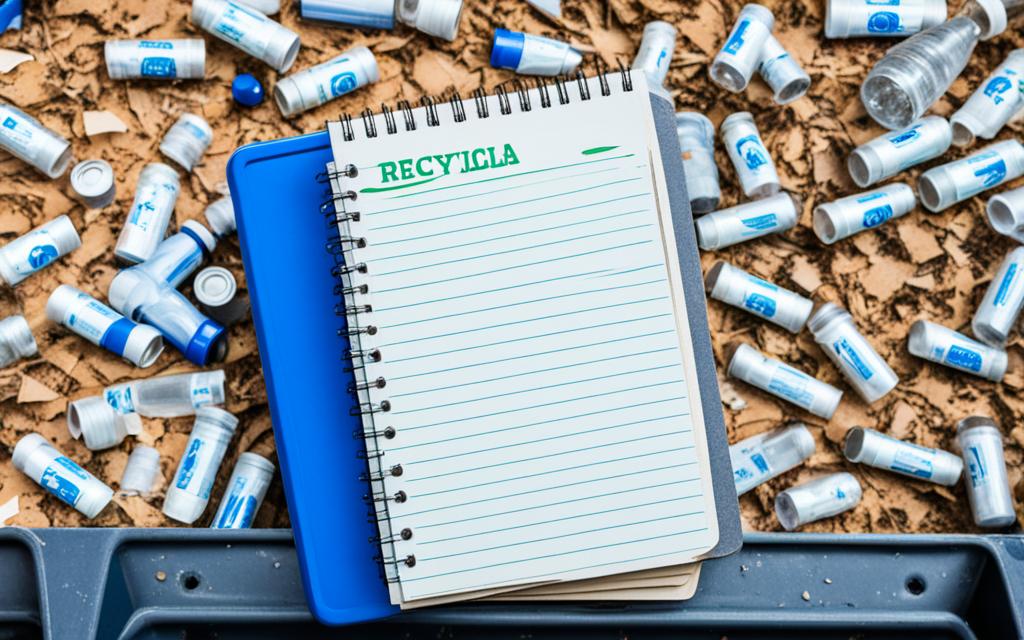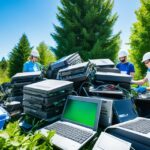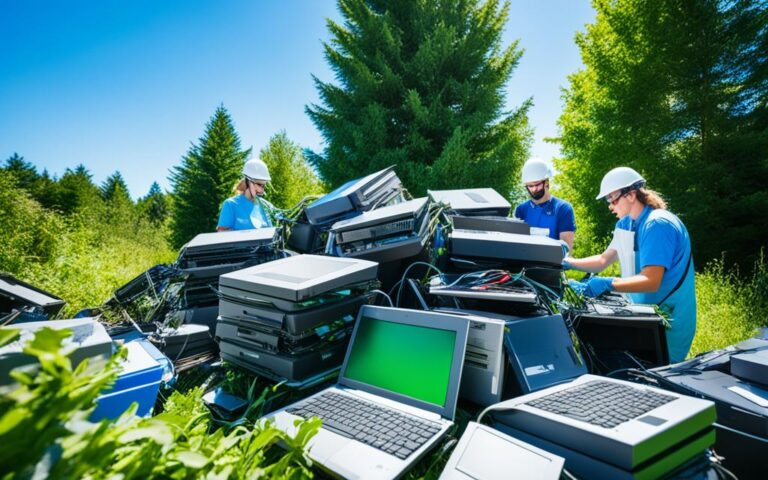The Ultimate Guide to Notebook Recycling: Best Practices
Notebook recycling is an essential practice in reducing waste and conserving resources. In this comprehensive guide, we will explore the best practices for recycling notebooks and promote eco-friendly disposal methods in the United Kingdom. By implementing these sustainable practices, you can make a positive impact on the environment and contribute to a greener future.
In today’s world, where sustainability matters, it is crucial to adopt eco-friendly practices to reduce waste and conserve resources. Proper notebook recycling plays a vital role in achieving these goals. By recycling notebooks, we can prevent valuable materials from ending up in landfills and instead redirect them for reuse or responsible disposal.
By following the best practices outlined in this guide, you can ensure that all components of a notebook, such as the plastic cover, paper pages, and metal or plastic coils, are recycled appropriately. This process not only reduces waste but also helps conserve resources and promotes a more sustainable future.
In the following sections, we will delve into the specific steps for recycling different notebook components. From understanding the various materials used to disassembling and recycling metal or plastic coils, we’ll provide you with the information you need to make environmentally-conscious decisions.
Additionally, we’ll explore alternative options such as going paperless by embracing virtual notes, which can further reduce paper waste and contribute to a greener society. Every small action counts when it comes to notebook recycling and sustainable disposal, so let’s embark on this journey together!
Understanding Notebook Components for Recycling
Before recycling a notebook, it is important to understand its components. Spiral notebooks typically consist of a plastic cover, paper pages, a metal or plastic coil, and sometimes a cardboard cover. Different notebooks may use various materials, including eco-friendly options such as recycled paper or plastics. By determining the composition of your notebook, you can make informed decisions on how to recycle each component in the most environmentally-friendly way.
When it comes to notebook recycling, identifying the different components is essential. Let’s break down the main parts of a notebook:
- Plastic Cover: Many notebooks have a plastic cover, which provides durability and protection. When recycling a plastic cover, check if it is made of a recyclable plastic type. Clean the cover thoroughly and dispose of it in the appropriate plastic recycling bin.
- Paper Pages: The paper pages are the core of any notebook. To recycle the paper pages, remove any staples or clips and separate them from the rest of the notebook. Place the paper pages in the designated paper recycling bin. Remember to remove any additional materials like sticky notes or bookmarks before recycling.
- Metal or Plastic Coil: Spiral notebooks typically have a metal or plastic coil that holds the pages together. If your notebook has a metal coil, you can recycle it by separating it from the pages and placing it in the designated metal recycling bin. Similarly, if the notebook has a plastic coil, check if the type of plastic used is recyclable, and dispose of it in the appropriate plastic recycling bin.
- Cardboard Cover: Some notebooks have an additional cardboard cover, which provides extra stability. If your notebook includes a cardboard cover, it is ideal for recycling in the paper recycling bin along with the paper pages.
By understanding these notebook components, you can ensure that each element is recycled appropriately, reducing waste and promoting a more sustainable future. Remember, responsible recycling practices play a vital role in preserving our environment and conserving valuable resources.
Recycling Plastic and Paper Components of a Notebook
To ensure the proper recycling of a notebook’s plastic cover, it is important to first determine if it is made from a recyclable plastic material. Clean the cover thoroughly to remove any dirt or debris. Then, dispose of it in the appropriate plastic recycling bin. By recycling the plastic cover, you contribute to the reduction of plastic waste and support the recycling industry.
When it comes to recycling the paper pages of a notebook, start by removing any staples, clips, or other non-paper materials. Separate the paper pages from the rest of the notebook to ensure proper recycling. Place the paper pages in the designated paper recycling bin. By recycling the paper pages, you help reduce the demand for virgin paper production and conserve valuable natural resources.
Recycling Plastic and Paper Components of a Notebook: Step-by-Step Guide
- Check the plastic cover for recyclable materials.
- Clean the plastic cover thoroughly.
- Dispose of the plastic cover in the appropriate plastic recycling bin.
- Remove any staples or clips from the paper pages.
- Separate the paper pages from the rest of the notebook.
- Place the paper pages in the designated paper recycling bin.
By following these simple steps, both the plastic and paper components of the notebook can be recycled and diverted from landfills. Recycling plastic and paper not only helps protect the environment but also conserves valuable resources.
Disassembling and Recycling Metal or Plastic Coils
If your notebook has a metal coil, it can be recycled by separating it from the pages. Place the metal coil in the designated metal recycling bin. Similarly, if the notebook has a plastic coil, check if the type of plastic used is recyclable. Dispose of the plastic coil in the appropriate plastic recycling bin. Alternatively, you can explore creative upcycling ideas for the metal or plastic coils, such as using them as hooks or paper clips. Recycling or upcycling the coils ensures that they are reused instead of ending up in landfills.
Recycling the metal or plastic coils in your notebook is an eco-friendly way to reduce waste and contribute to a sustainable future. By properly disassembling and disposing of these components, you can play a part in the recycling process. Additionally, upcycling the coils introduces creative possibilities to repurpose them for practical use.
Considering Alternative Options and Going Paperless
When it comes to reducing paper waste, exploring alternative options and going paperless can make a significant impact. By embracing virtual notes on your phone, tablet, or laptop, you can reduce the need for traditional notebooks and contribute to a greener future.
Virtual notes offer a convenient and eco-friendly solution by eliminating the reliance on paper. They are easily accessible, allowing you to access your notes wherever you go, without the hassle of carrying around bulky notebooks. Additionally, virtual notes provide better organization with the ability to search, tag, and categorize your notes effortlessly.
Going paperless not only reduces the consumption of paper, but it also helps to conserve natural resources, such as forests and water. By opting for virtual notes, you can be a part of the solution in reducing paper waste and protecting the environment for future generations.
Embracing a paperless approach provides alternative options that are more sustainable and cost-effective compared to traditional notebooks. By adopting virtual notes as an alternative, you can significantly reduce your environmental footprint while maintaining efficiency and productivity in your everyday life.
Conclusion
In conclusion, notebook recycling plays a vital role in reducing waste and conserving resources. By responsibly disposing of the various components of a notebook, including plastic covers, paper pages, and metal or plastic coils, individuals can actively contribute to a more sustainable future. Adopting eco-friendly practices, such as recycling and upcycling, promotes a greener society and helps to minimize our environmental impact.
Additionally, considering alternative options like going paperless can further reduce the overall usage of notebooks and paper waste. Embracing virtual notes on electronic devices such as phones, tablets, or laptops not only eliminates the need for physical notebooks but also offers greater accessibility and organization. Going paperless is a cost-effective and environmentally friendly choice that helps to conserve resources and reduce our carbon footprint.
It is important to remember that every small action counts when it comes to notebook recycling and sustainable disposal. Whether it’s separating the plastic cover from the paper pages, recycling the metal or plastic coils, or making the switch to virtual notes, these choices collectively contribute to a more sustainable society. Let’s continue to prioritize eco-friendly practices, reduce waste, and conserve resources for a brighter and cleaner future.
FAQ
What materials are commonly found in spiral notebooks?
Spiral notebooks typically consist of a plastic cover, paper pages, a metal or plastic coil, and sometimes a cardboard cover.
How can I recycle the plastic cover of a notebook?
To recycle a notebook’s plastic cover, check if it is made of a recyclable plastic type. Clean the cover thoroughly and dispose of it in the appropriate plastic recycling bin.
What should I do with the paper pages of a notebook?
For the paper pages, remove any staples or clips and separate them from the rest of the notebook. Place the paper pages in the designated paper recycling bin.
What should I do if my notebook has a metal coil?
If your notebook has a metal coil, it can be recycled by separating it from the pages. Place the metal coil in the designated metal recycling bin.
How should I dispose of a notebook with a plastic coil?
If the notebook has a plastic coil, check if the type of plastic used is recyclable. Dispose of the plastic coil in the appropriate plastic recycling bin. Alternatively, you can explore creative upcycling ideas for the metal or plastic coils.
Can I go paperless and reduce the need for notebooks?
Yes, as an alternative to traditional notebooks, consider going paperless by using virtual notes on your phone, tablet, or laptop. This reduces the need for paper and helps minimize paper waste.
Why should I consider going paperless?
Going paperless is more affordable, easily accessible, and provides better organization. By adopting a paperless approach, you can significantly reduce your environmental footprint and contribute to a greener future.
How does proper notebook recycling contribute to a sustainable future?
By properly disposing of each component, including plastic covers, paper pages, and metal or plastic coils, you can contribute to reducing waste and conserving resources. Implementing these eco-friendly practices fosters a greener and more sustainable society.













